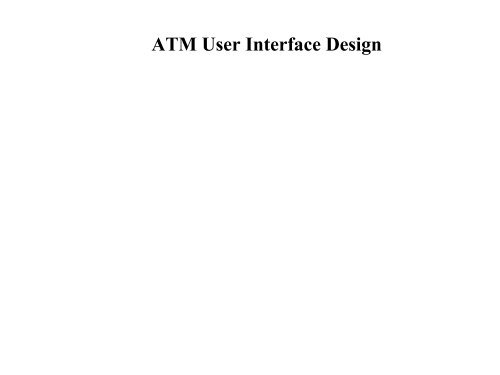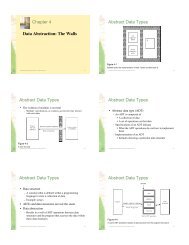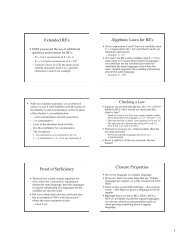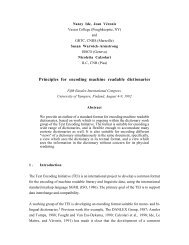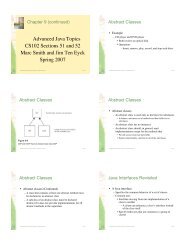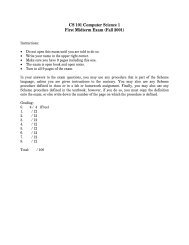ATM User Interface Design
ATM User Interface Design
ATM User Interface Design
Create successful ePaper yourself
Turn your PDF publications into a flip-book with our unique Google optimized e-Paper software.
<strong>ATM</strong> <strong>User</strong> <strong>Interface</strong> <strong>Design</strong>
Requirements<br />
A statement of requirements for a portion of the system may be extracted<br />
from the use cases and other Inception documents. A brief narrative is<br />
useful for identifying the problem domain objects (concepts).<br />
A bank customer is able to access his or her account using an automatic teller<br />
machine. To be able to use an <strong>ATM</strong> a customer must first register an account<br />
number and a passcode number. The customer’s information is then added to a<br />
list of registered users. The <strong>ATM</strong> user interface consists of a keypad, a display<br />
window, a selection of choice options, and a help screen that displays<br />
instructions for completing an <strong>ATM</strong> transaction. <strong>User</strong>s are asked to enter their<br />
account number from the keypad followed by their passcode. If the customer is<br />
a valid user, instructions are given for choosing a transaction. During a<br />
transaction, the user’s account is accessed and updated. Upon completion of a<br />
transaction, the user may elect to make another transaction or to quit.<br />
This prototype simulates the actual machine that includes a card reader and<br />
buttons implemented in the hardware.
Requirements<br />
Identify the noun phrases and verb phrases in the narrative<br />
A bank customer is able to access his or her account using an automatic<br />
teller machine. To be able to use an <strong>ATM</strong> a customer must first register an<br />
account number and a passcode number. The customer’s information is<br />
then added to a list of registered users. The <strong>ATM</strong> user interface consists of<br />
a keypad, a display window, a selection of choice options, and a help screen<br />
that displays instructions for completing an <strong>ATM</strong> transaction. <strong>User</strong>s are<br />
asked to enter their account number from the keypad followed by their<br />
passcode. If the customer is a valid user, instructions are given for<br />
choosing a transaction. During a transaction, the user’s account is accessed<br />
and updated. Upon completion of a transaction, the user may elect to make<br />
another transaction or to quit.
List of Noun Phrases<br />
Bank customer<br />
Account<br />
Automatic teller machine<br />
<strong>ATM</strong><br />
Account number<br />
Passcode number<br />
Customer information<br />
List of registered users<br />
<strong>ATM</strong> user interface<br />
Keypad<br />
Display window<br />
Help screen<br />
Selection of choice options<br />
Transaction<br />
Concept<br />
Concept<br />
Redundant, same as <strong>ATM</strong><br />
Concept<br />
Attribute<br />
Attribute<br />
Concept<br />
Concept<br />
Concept<br />
Concept<br />
Concept<br />
Concept<br />
Concept<br />
Concept<br />
But in this example the <strong>ATM</strong> relates only to<br />
the user interface – same as <strong>ATM</strong><br />
Instructions<br />
Attribute<br />
Text strings
Associations<br />
Customer accesses Account (via <strong>ATM</strong>)<br />
Customer Information is added to List of registered users<br />
<strong>ATM</strong> consists of Keypad, Display, Help screen, Selection of choice options<br />
Account is accessed by (<strong>ATM</strong>)<br />
<strong>ATM</strong> verifies Customer Information<br />
Implicit<br />
Customer has Account<br />
Keypad has Buttons<br />
Choice Selection uses Buttons<br />
Draw a Domain Model relating these Concepts
State Transition Diagram
Implementation of a Prototype<br />
To provide an illustration of the <strong>ATM</strong> user interface, we will implement<br />
an Applet that uses stubs to represent the Account, <strong>User</strong>List, and<br />
CustomerInfo objects.<br />
The prototype shows a working model of the user interface<br />
with the message sequence that the customer will encounter.<br />
The purpose of the prototype is to examine the human<br />
factors issues relating to the interface and to make certain<br />
that there are no deadlocks or partial cycles and that each<br />
transaction will properly terminate and return the system<br />
to the welcome state.<br />
The <strong>ATM</strong> <strong>User</strong> <strong>Interface</strong>
Test Plan for the <strong>User</strong> <strong>Interface</strong> Prototype<br />
Test Plan for the <strong>Interface</strong> Prototype<br />
1. Specify the paths through the system to be tested<br />
Welcome screen (ask for Account Number) (DIGITS + ENTER) <br />
Passcode State (Ask for Passcode) (DIGITS + ENTER) <br />
Select State (Show Options) (DEPOSIT or WITDRAW + ENTER) <br />
Deposit State or Withdraw State (Key-in amount and press ENTER) <br />
Other State (Ask if user wants to make another transaction) (CLEAR = NO) <br />
Goodbye screen (if answer is NO) (CLEAR) <br />
Welcome screen is returned<br />
Alternative paths from Select State<br />
<strong>User</strong> aborts transaction by pressing CLEAR Goodbye (CLEAR) Welcome<br />
<strong>User</strong> selects check balance (BALANCE) Other State (CLEAR = NO) <br />
Goodbye screen (CLEAR) Welcome
Test Plan for <strong>User</strong> <strong>Interface</strong> Prototype<br />
Other Alternate Paths<br />
After a Deposit or Withdrawl make another transaction<br />
Deposit (ENTER) Other State(ENTER = YES) Select screen (BALANCE)<br />
Other State (CLEAR = NO) Goodbye screen (CLEAR) Welcome<br />
Test that pressing ENTER before keying in the amount of the deposit or<br />
withdrawl will generate the appropriate error message recovery sequence.<br />
2. When debugging and testing the prototype, keep a log of corrections<br />
and changes made in the code.<br />
You should NOT record simple errors like missing semicolons, missing<br />
parentheses, or misspelled identifiers, but errors that lead to changes in the code<br />
like adding the boolean hold flag to ensure that the goodbye screen would<br />
display after a balance check.<br />
Changes to the code made during debugging and testing can modify or<br />
override design decisions and should be documented for later review.
Results of Testing<br />
Errors Detected<br />
•Account numbers and passcodes that are 9 digits or longer can<br />
cause integer overflow errors.<br />
•If ENTER is pressed before an amount is indicated when<br />
performing a withdrawal, then ENTER must be pressed twice<br />
after an amount has been entered before the correct screen is<br />
displayed.
Plan for the Next Iteration<br />
Start Date: Sept. 9, 2004 Due Date: Sept. 23, 2004<br />
Artifact<br />
Use cases:<br />
Withdrawal<br />
Deposit<br />
Check Balance<br />
Actor-Goal List<br />
Use case diagrams<br />
State Model Diagram<br />
Prototype<br />
Comment<br />
Use cases describe the main sequence scenario and lists<br />
alternate sequence scenarios (to be developed in next<br />
iteration). Fully dressed use cases are begun for each of<br />
these goals.<br />
Identify the stakeholders (and external systems) and make a<br />
list of the goals that each might have.<br />
From the Actor-Goal List, identify use cases and the actors<br />
that participate in each. Display the system boundary.<br />
Add error states for incorrect passcode – do not accept<br />
passcodes with more than 6 digits.<br />
Construct a table for verifying user accounts/passcode.<br />
Construct a database for user accounts and incorporate these<br />
data bases into the <strong>ATM</strong> simulation.
Homework<br />
Complete the artifacts listed in the iteration Plan. In particular:<br />
1. Write use cases for Witrhdraw, Deposit, and Check Balance (as<br />
described in the comments.)<br />
2. Construct an Actor-Goal List and Use Case Diagram.<br />
3. Construct a Table for verifying account number/passcode pair. Assume<br />
that Account numbers are pre-assignned and let the passcodes be<br />
established at that time. (You may add the ability for a user to change<br />
his/her passcode as an option in this iteration.<br />
4. Construct a database for user accounts. (A structure of your own<br />
creation holding account information and providing methods for<br />
performing transactions will suffice here.)<br />
5. Incorporate the databases into the prototype system. Add checking of<br />
account number/passcode for valid user (and don’t allow passcode<br />
numbers greater than 6 digits).<br />
6. Write a test plan for testing the prototype and perform test.


